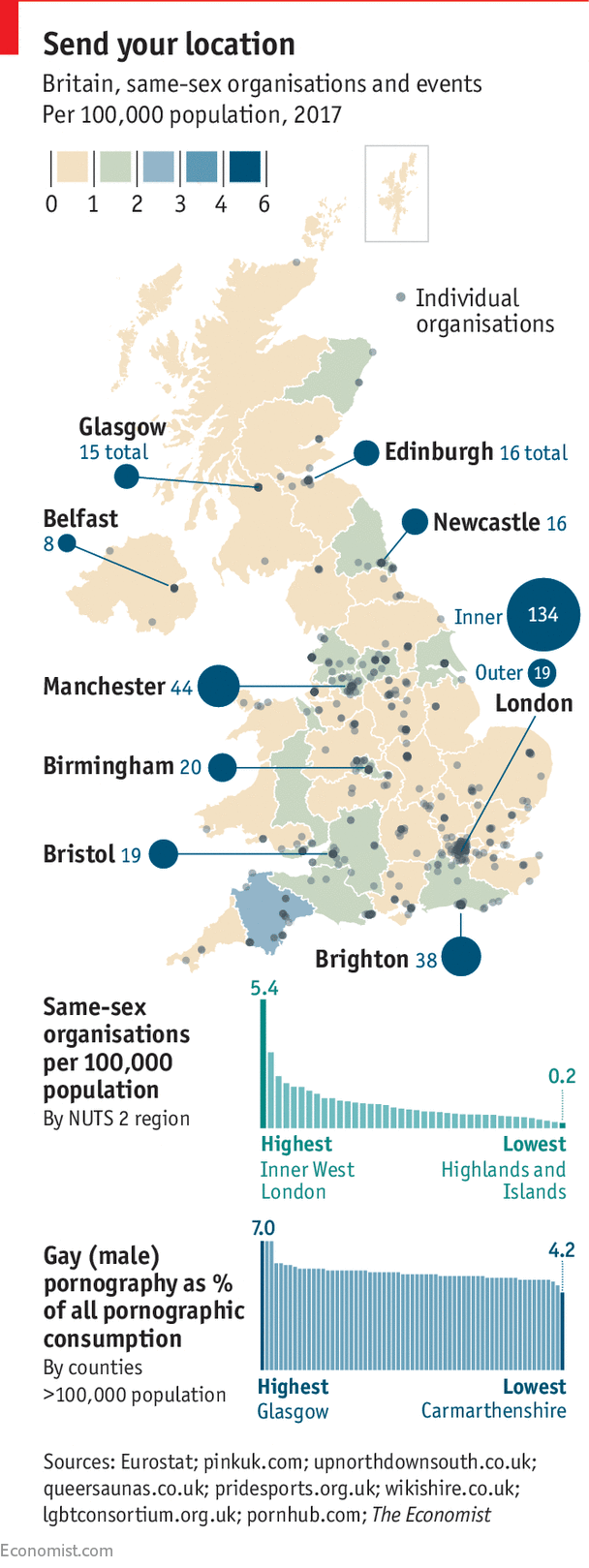WITH its cream teas and rolling gardens, Dartington Hall in Devon resembles a picture postcard of the conventional, conservative English countryside. Yet at the end of September the estate hosted the first Dartington Outing, a week-long jamboree of “queer arts and bent events”, featuring lesbian life drawing, a virtual-reality tour of a gay HIV-positive man’s body, and a “rainbow tea party”.
Some Devonians may have been surprised to find such sexual colour in rural Britain. “The media perception of gay life is young, urban and hedonistic, which is what is received by the wider public,” says Justin Bengry, a historian of sexuality at Goldsmiths, University of London. But queer life beyond the city is increasingly visible, on screen and in real life. “God’s Own Country”, a recent film, depicts a romance between two young shepherds in Yorkshire. Pride parades trundle through towns from Colchester to Chesterfield. “Some local older people never thought Pride would be in Totnes in their lifetimes,” says Max Price, who co-runs Proud2Be, a support network in Devon.
Measuring the spread of gay Britain is difficult. Surveys reach wildly different conclusions depending on their methodology. The official Annual Population Survey finds that 93.4% of interviewees define themselves as straight, with 4.1% offering no answer and 2.5% identifying as homosexual, bisexual or “other”. By contrast an online poll by YouGov, which asked people to plot their sexuality on a seven-point spectrum, found that only 72% considered themselves exclusively straight. Among 18- to 24-year-olds less than half did.
If counting gay people is tricky, mapping them is harder still. How much do events like the Dartington Outing say about where the gay population lives?
For a sense of where queer life is most visible, we scraped listings websites for the details of gay and lesbian organisations. These included everything from charities and church groups to social clubs and saunas. Some results were surprising: per person, Devon has among the most gay establishments in the country. But broadly the pattern conforms to the urban stereotype. The highest concentrations of gay organisations are in cities—London, Manchester, Brighton—whereas most of the countryside is poorly served.
But this may not say much about where gay people actually live. Though statisticians struggle to get Britons to reveal their sexual preferences, Pornhub, the internet’s most popular adult site, has no such problems. The anonymised browsing habits of its British visitors this year show that gay content accounts for 5.6% of viewing (this excludes lesbian porn, for which the main audience is straight men). Whereas gay establishments are clustered, gay porn consumption is evenly spread, with 97% of the country within a percentage point of the national average (see chart). That suggests that, though visible gay life is still mainly urban—with festivals like the Dartington Outing the growing exception—gay people are more widely dispersed.

Is this a new phenomenon, or are previously hidden communities simply coming out into the open? Evidence of rural gay life from decades ago is limited to local news reports of men being arrested for having sex in parks; lesbians were almost invisible. Prejudice is still a problem: more than half of gay men do not feel comfortable holding hands in public, according to Stonewall, a charity. But 64% of people now think that same-sex relationships are “not wrong at all”, up from 11% in 1987, according to the British Social Attitudes survey. Where once pubs kept a back room without a sign for gay people, today they fly rainbow flags, even in rural areas.
Zero feet away
There may also have been movement to the countryside. Dating apps have made it easier to find partners in out-of-the-way places. Before apps such as Grindr, which claims more than 1m users in Britain, and Her, a similar app for lesbians, gay people had to travel to bars in cities. Many never left. These days, staying in the sticks is more viable. Although the lovers in “God’s Own Country” meet at work, in real life two such men might be more likely to meet online (though one complains that his phone signal in Yorkshire is terrible).
A rising number of gay people are growing grey in the countryside, too, as their straight counterparts have long done. Jonathan Cooper and his partner, in their 50s, moved from London to Devon last year and found many others who had done the same. “The best B&Bs down here tend to be run by gay men who’ve moved from the city,” says Mr Cooper. “We all want to be exceptional, but it turns out we’re not.”
Collecting oral histories of gay life in the rural south-west, Alan Butler, a historian at Plymouth University, heard one line over and over from elderly interviewees: “I never made a fuss.” As events such as the Dartington Outing show, the fuss is now out in the open.
Source link
No comments:
Post a Comment